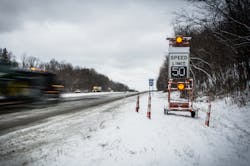By: John MacAdam and Marissa McDaid
In Lake County, Ohio, winter weather spells trouble for a stretch of I-90 between S.R. 528 and S.R. 44.
Over a 10-year span, more than 800 winter crashes were recorded along this corridor. On Dec. 8, 2016, an intense snow band that produced massive squalls contributed to a bus crash that led to a multi-car pileup of more than 50 vehicles, a scene all-too familiar to local responding agencies that witnessed a remarkably similar incident in December of the previous year.
Northeastern Ohio is no stranger to winter weather, where areas of Ashtabula, Geauga and Lake counties can see more than 100 in. of snowfall annually. Unique to regions surrounding the Great Lakes, lake-effect snow can deposit more than 1 in. per hour, drastically reducing visibility and resulting in rapid accumulation. Lake-effect snow occurs when fronts of cold air pass over warm bodies of water. The location of I-90 along Lake Erie’s shore makes it a prime candidate for lake-effect squalls, known to surprise even the most experienced drivers.
“Drivers experience a rapid change in weather and road conditions,” explained Lake County Sheriff Daniel Dunlap, regarding winter on I-90. “After driving 60 to 70 mph on relatively clear roadways, they basically come to a curtain of snow. Over a distance of 3-4 miles, [accumulation] can go from very little snow to well over a foot of snow.” After much discussion, partnering agencies agreed that a 10-mph speed-limit reduction was the first step in encouraging drivers to understand the unique threat that snow squalls posed in this corridor.
Finding a fix
Looking for a quick way to reduce the risk and severity of multi-car and secondary crashes, on January 2017 the Ohio Department of Transportation (ODOT) temporarily reduced the 70-mph stretch of I-90 between S.R. 91 and Vrooman Road to 60 mph through April 1. Ongoing discussions with the Lake County Sheriff and Ohio State Highway Patrol made it apparent that speed was a high contributing factor to severe winter crashes. Speed data from the day of the December 2016 crash showed that even after entering the lake-effect snow band, vehicles had continued to travel in excess of 70 mph.
While the seasonal 10-mph speed-limit reduction on I-90 through Lake County caught the attention of the highway’s frequent travelers and local media, critics questioned its effectiveness. On days where no winter weather was predicted during the three-month period of the temporary reduction, commuters found themselves frustrated by the lowered speed limit. At the time, the Ohio Revised Code only allowed for the use of variable speed limits (VSL) within construction work zones. Interest in establishing a VSL corridor grew as local agencies and motorists discussed the safety of the corridor.
“If we can get people to slow down, that will give them more reaction time when there’s a crash ahead,” said Ohio State Highway Patrol Lt. Charles Gullet. “I definitely feel [variable speed limits] will be a step in the right direction to reduce crashes in that area.”
Legislation was passed in Summer 2017 that gave ODOT the go-ahead to move forward with designing a VSL corridor on I-90 between I-71 and the Ohio and Pennsylvania border. The limits of the project were narrowed to the stretch of I-90 between S.R. 44 and S.R. 528, a span that once saw 11 to 50 crashes per snow event—some that were multi-vehicle pileups.
With only a few months to install the new system before winter began in Ohio, ODOT was tasked with the challenge of showing the public that change was on the way. Plans for the new VSL corridor were finalized and sign fabrication began. In preparation for the upcoming snow and ice season, temporary VSL signs similar to those used in work zones were placed in four eastbound and four westbound locations on I-90.
During the 2017-2018 winter, there were no multi-car incidents reported.
Trying it out
The temporary VSL system served as a test-run for ODOT’s Traffic Management Center (TMC), Highway Management Administration, public information office, and project engineers. ODOT looked to the Federal Highway Administration’s Synthesis of Variable Speed Limits for guidance when developing criteria for a speed-limit reduction. By combining FHWA’s research with ODOT’s locally observed conditions, the department created a VSL policy that considers the road’s pavement conditions, visibility, precipitation, vehicle incidents and traffic congestion.
The maximum speed limit for the corridor is 70 mph, while the lowest speed limit, 30 mph, is reserved for high-impact incidents such as a road closure. The speed limit of the road is reduced in 10-mph increments as conditions warrant. For example, a moderate amount of precipitation may merit a 60-mph speed-limit change, while drifting conditions or low visibility could further reduce the speed limit to 50 mph. To facilitate speed changes, the ODOT TMC developed an application to determine which speed was appropriate for the roadway based on the various VSL criteria. When the speed limit of I-90 changes, the TMC application sends an e-mail message to key ODOT personnel. Staffing of the ODOT TMC was expanded to allow one designated employee to monitor the corridor 24 hours a day.
When the permanent VSL corridor debuts during the 2018-2019 snow and ice season, the project will feature 19 permanent digital speed-limit signs, nine eastbound and 10 westbound along this stretch of I-90. The project also includes the addition of five closed-circuit television cameras, three additional Roadway Weather Information Systems (RWIS) and several pavement sensors that assist in supplying the TMC and the motoring public with up-to-date road conditions. In coordination with the National Weather Service, a snow squall warning system was established. Six dynamic message signs display warnings to drivers when whiteout conditions are expected.
Looking ahead
During the 2017–2018 snow and ice season there were zero multi-car incidents reported in the VSL corridor. For the upcoming winter seasons, ODOT continues to assess ways that the VSL corridor can be improved. Currently, speed-limit changes are posted on social media outlets to inform the public and local agencies. Possible future plans include displaying the current I-90 speed limit on ODOT’s traffic app and website OHGO. Ohio’s smart mobility initiative, DriveOhio, has designated the stretch of I-90 the “Lake Effect Corridor.” The hope is that smart mobility technology will eventually allow the speed limit to be delivered to connected vehicles using a wireless signal. With a successful pilot, the Lake Effect Corridor will continue to be improved to increase safety and mobility for I-90 motorists.
About The Author: MacAdam is administrator of the Ohio Department of Transportation’s Office of Traffic Management. McDaid is public information officer for the Ohio Department of Transportation’s District 12.



